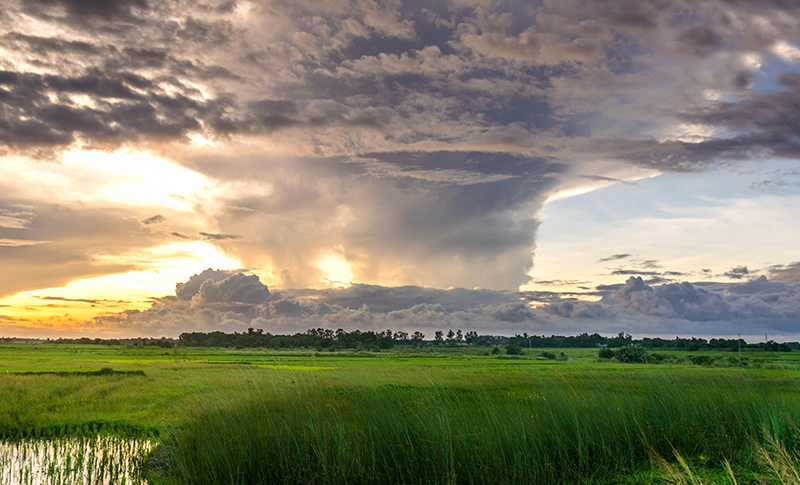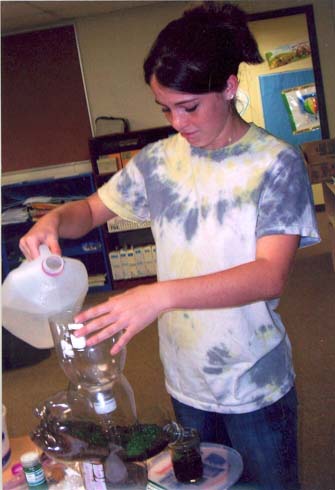Environment and Conservation

Agriculture is a Cycle
Students will make bracelets representing life cycles.
Are You Thirsty? The Effects of Pollution on Drinking Water
Various activities for helping students visualize the effects of pollution on drinking water.
Be a Bug Scout
Students count insects or specified weeds in a given area to experience how farmers decide whether or not to use pesticides.
Bee Dance
The student will construct bee puppets and use them to act out some bee behaviors.
Biomass: The Energy of the Future
Students will use research skills to gather information on renewable fuels. Students will compile information on a graph and compare and contrast the pros and cons for developing the fuels for use.
Black Mesa: Where the Rocky Mountains Meet the Short Grass Prairie
Students read about the history, topography and environment of Black Mesa, develop experiments to demonstrate erosion and formation of a mesa, find land features on maps and research related topics.
Bubbles in the Cabbage Juice
Students will conduct experiments with cabbage juice as an indicator to identify carbon in a variety of substances.
Bug's Eye View
Students construct an insect holder and observe and classify insects.
Buried Treasure: Oklahoma's Aquifers
Students will read about the hydrologic cycle, groundwater and aquifers, locate aquifers in Oklahoma and build models to show the permeability of different earth materials.
Circles in the Landscape: Irrigating Oklahoma Crops
Students examine transpiration, evapotranspiration and water balance, learn the reasons for irrigation, analyze Oklahoma weather information and use geometry and other math skills to design an irrigation system.
Creepy Crawly Critters
Students will learn characteristics of insects by creating models from an assortment of materials.
Dark Days on the Prairie
Students write descriptive paragraphs based on pictures from the Dust Bowl, label a map showing the Oklahoma counties and surrounding states affected by the Dust Bowl, and research climatic conditions of the area.
Dirty Pictures
Student compose pictures using the many different colors of Oklahoma soil.
The Farmer Cares for the Land
The student will identify cause and effect relationships in issues relating to agriculture and the environment.
From Shelter to Playing Fields: Oklahoma Sod
Students will read about the importance of sod in Oklahoma history and as an Oklahoma-grown product in today's economy. Students will complete math problems related to sod. Students will conduct experiments with a purchased roll of sod. Students will conduct an experiment to demonstrate the usefulness of sod in preventing soil erosion.
Harvest the Wind
Students read about wind power and wind farms, make a pin wheel and develop their own inventions for harvesting wind power.
The History of Ethanol in America
Students will explore the production of biofuels from the 1850s to the present.
The History of Irrigation on the Great Plains
Students examine the history of irrigation on the Great Plains, create a timeline to organize the information and research to learn about irrigation around the world.
If Not for the Pollinators: Matching Flowers with Pollinators
Students match flowers to pollinators and construct models of flowers to demonstrate why different kinds of flowers need different kinds of pollinators
Just Lookin' for a Home
Students will learn a song about the boll weevil and use it to understand the impact agriculture has on a community and its economy.
Let It Rain
Demonstrations showing students the effects of water erosion on soil.
Look Out, Below!
Student learn the four layers of soil and identify the substances that make up each level.
A Lovely Captive
Students will construct a habitat which will allow them to observe the metamorphosis of a caterpillar into a butterfly.
Making Paper
Students make paper from recycled paper.
Manure Happens: Nutrients in Livestock Manure
Students reinforce science and math skills while learning about the nutrients found in livestock manure.
Measuring Exponential Growth
Students reinforce math skills while learning about best practices for use of animal manure nutrients and protection of water quality.
Mighty Earth Movers
Students build a habitat for worms and record observations.
Mighty Oaks From Little Acorns
Students make the connection between seeds and trees by gathering and planting acorns.
Modifying the Plow
Grades 3-5: Sci, SS, ELA, Visual Arts, Math
Students will learn how plows have been modified through the years to improve their use and impact on farming. Students will read about the Dust Bowl and discover how Oklahoman Fred Hoeme's modification of the plow helped reduce wind erosion. Students will design a plow replica using a variety of supplies and then test the effect the plow has on a tray of soil. Students will use the elements and principles of design to analyze artwork that portrays plowing fields. Students will discuss the artists portrayal of plowing a field.
Mud in the Water
The student will build a soil erosion model and learn the importance of soil conservation.
Oklahoma Soils
Students read about Oklahoma soils and how they were formed and answer questions from a chart showing the soils found in Oklahoma's major land resource areas.
Paper or Plastic? Exploring Renewable Resources
Students discuss, develop, invent and implement a plan for making informed personal economic decisions about renewable resources.
Playing in the Dirt: Discovering Soil
Grades 7-8: Sci
Through classroom experiences, students will compare different types of soil found around their school and home to identify three basic soil components. Students will also develop an experiment to discover the effect of soil types on seed germination.
Playing in the Dirt: Discovering Soil
Grades 9-12: Sci
Through classroom experiences, students will compare different types of soil found around their school and home to identify three basic soil components. Students will also develop an experiment to discover the effect of soil types on seed germination.
Pollinator Habitats
Students research, interview experts and design pollinator habitats
Preparing for Drought
Students form subcommittees to propose plans for drought management and relief.
The Role of Fire
Grades 6-8: Math, Science
At the end of this lesson students will be able to identify the roles of fire in the environment. Students will describe the danger of wildfires. Students will create recommendations for prescribed burning.
The Role of Fire in Healthy Prairie, Brush and Forest Land
The importance of fire to maintaining the health of prairie, brush and forest lands.
Save Our Soil: Exploring Agricultural Land Use
Students will learn about the distribution of agricultural land through a demonstration with an apple representing the earth. Students will discuss the impacts of land development. Students will make land use decisions for a variety of situations and justify their decisions. Students will answer questions from a chart showing land use and ecosystem types in select countries from different regions.
Soak It Up
Student do an experiment with different kinds of soil to observe how well each holds water and how organic matter increases the amount of water soil will hold.
Symbiosis in Agriculture
Students compare insect relationships according to their symbiosis class—parasitism, commensalism, mutualism.
Thomas Jefferson's Useful Plants
Students will read about Thomas Jefferson's efforts to find plants that would grow well in the new country. Students will taste and research unfamiliar fruits and vegetables, learn about Jefferson's instructions to Lewis and Clark and follow some of his instructions to explore a defined local area, experience successes and failures by growing a variety of plants from seed, discuss the pros and cons of introducing new plants to an ecosystem.
Weather Matters
Students will read about the effects of weather on agricultural production and explore the Oklahoma Mesonet site to find and graph local rainfall data. Students will examine weather-related works of art.
Weeds on the Windowsill
An examination of the need for pesticides. Students compare the results when they grow plants in two kinds of garden soil, one of which has been treated (by boiling water) to kill weed seeds and one which has not.
What is Drought?
Students conduct an experiment to explore the effects of drought.
Will Your Car Run on Grass? How Biomass Becomes Alcohol
Students conduct experiments with yeast to determine what substances promote fermentation.

